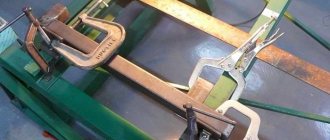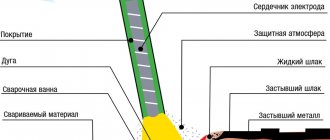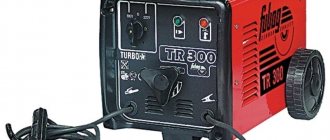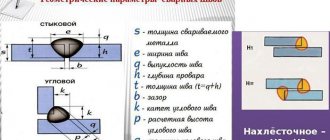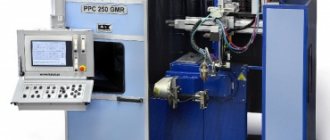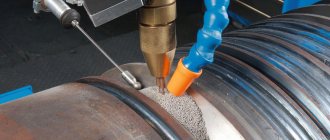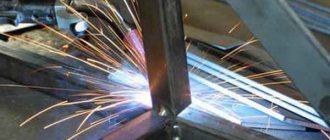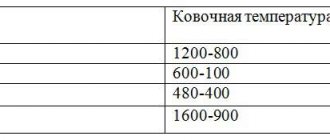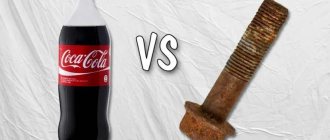Surfacing is the application of an additional layer of metal to the surface of various products and parts by welding.
This procedure not only restores the original properties of the part, but also gives it additional valuable characteristics. It is one of the simplest and most effective ways to return elements to functionality. Fusing can be done for various purposes :
- restoration of product geometry;
- giving the structure a new shape;
- formation of a layer with specific physical and mechanical properties;
- increasing wear resistance, anti-corrosion, strength, hardness and other properties of the base material.
The essence of the process is the interpenetration of hot materials into each other, occurring at the molecular level. To do this, the surface layer of the main product is heated until it melts to a small depth, and the additive is heated to a liquid state. The resulting connection has a high level of reliability. The main advantage of the technology is the ability to regulate the thickness of this layer within significant limits and apply the additive to elements of various shapes.
Below you will find a detailed overview of all types of surfacing, and then a detailed discussion of surfacing with electrodes.
Types of metal surfacing
Currently, a large number of surfacing methods are used in the industrial and manufacturing fields. Next we will look at the different types of surfacing depending on the type of surfacing material used.
Manual arc surfacing with coated electrodes
Surfacing with coated electrodes is the most universal method; it can be carried out in all spatial positions. It is used both in the industrial sector and in the domestic sphere.
- The popularity of this method is due to several reasons : simplicity, convenience, flexibility, and no need for special equipment.
- Main disadvantages : low productivity, difficult conditions for the performer, instability of the quality of the resulting layer, large penetration of the base material.
Fusing requires the performer to have certain skills.
It is necessary to melt both components at a minimum current. By determining the composition of the metal, the type of electrode is selected, and the thickness and shape of the workpieces affects the diameter of the welding rod. If the thickness of the deposited material is less than 1.5 mm. – then the diameter of the rod should be 3 mm. With a thickness of more than 1.5 mm. – 4-6 mm.
The surface of the part must be cleaned of various types of contaminants.
The need for preheating and subsequent heat treatment also depends on the brand of electrodes used.
Surfacing of steel products is carried out using direct current of reverse polarity.
This method involves the use of various patterns of surfacing welds.
When working with flat products, there are two main types:
- using narrow rollers (in the picture), each subsequent roller should overlap the other by 0.3-0.4 of its width;
- the use of wide rollers, which are obtained with increased transverse movements of the electrode.
Another type is the laying of narrow rollers at some distance from each other. The slag crust is removed after applying several rollers. Then the gaps are also filled with rollers.
Surfacing of cylindrical products is carried out in three ways:
- rollers along the generatrix of the cylinder;
- rollers in closed circles;
- along a helical line.
Cylinder surfacing will be analyzed in more detail below.
Manufacturers and retailers offer a wide range of coated surfacing electrodes. The most popular brands are:
OZN-6 are used for surfacing parts of equipment for various purposes, operating under conditions of significant shock loads and intense wear. Metal deposited using electrodes of this brand has increased resistance to cracking.
OZI-5 electrodes are used for welding of metal-cutting tools and dies. The deposited metal is highly resistant to crushing and abrasion under significant impact loads.
Manual arc surfacing can also be carried out with carbon, graphite or tungsten electrodes. Deposition with these welding materials has limited application and is therefore rarely used.
Vibro-arc surfacing is performed by vibrating the electrode, the amplitude of which is 0.75-1.0 times the diameter of the rod. The procedure is carried out using a reverse polarity current of 80-300 A. At the moment of contact between the main product and the electrode wire, a short circuit occurs, which heats both surfaces to the melting temperature.
This method allows you to obtain a durable and thin layer. At the same time, slight heating eliminates the deformation of the part.
The vibro-arc method is used for fusing external and internal cylindrical, external conical and flat surfaces. This method is also used to restore the following structures: shaft journals, mud pump rods, drill pipe joints and others.
Electroslag surfacing is based on the use of heat generated when current passes through molten slag. The main feature of this method is high productivity. In an hour of work, a performer can obtain hundreds of kilograms of deposited metal. Other characteristic features of ESP: lack of spattering, economical consumption of filler materials and electricity, low heating and cooling rates have a negative effect on the structure of the deposited layer, and a slight tendency of the metal to form pores . [ads-pc-2][ads-mob-2]
For your information! To obtain a stable process, it is necessary that the depth of the slag bath be at least 30 mm. Failure to comply with this rule leads to instability of the process.
Electrodes of various cross-sections can be used as filler material: rods, plates, etc.
Main advantages: the process remains stable in a wide range of current densities: 0.2-300 A/mm2, the ability to deposit layers of large thickness in one pass, this method can be used to work with materials prone to cracking, the ability to give the deposited metal the desired shape .
The main disadvantages: overheating of the main product in the heat-affected zone due to the high heat input of the process, the need for complex and unique equipment, the impossibility of obtaining thin layers, significant preparation time.
Automatic plasma surfacing complex SBI (Austria)
Currently, the plasma cladding method . The heat source is a high-temperature compressed arc produced in special burners. The filler material can be surfacing powder, tape, wire, electrode, etc.
Plasma surfacing with the supply of two consumable electrodes into the bath provides high productivity.
A universal subtype of plasma surfacing is surfacing with powder injection into an arc. When performing such work, a combined type burner is used, which produces two types of arc: direct and indirect. Surfacing powders are fed from the feeder to the burner using a transport gas and are blown into the arc there. During its stay in the arc, most of the powder melts, and it falls on the surface of the main product in the form of droplets.
Before starting welding, the working surface should be cleaned of various contaminants: rust, moisture, scale and oil.
When applying the first surfacing layer, each previous bead must be overlapped by 20-30% of its width.
- Main advantages : high quality of the deposited layer, small depth of penetration of the base metal, high adhesion strength, the ability to obtain layers of small thickness.
- Disadvantages : relatively low level of productivity, presence of complex equipment.
Submerged arc surfacing has several characteristic features: high productivity, great versatility and wide possibilities for alloying the base metal.
There are four types of submerged arc surfacing:
Electric arc surfacing with tape is widely used . The arc that occurs at the end of the electrode strip moves from one edge to the other. These cyclic movements result in a dissipated heat input into the main product.
2. Multielectrode electric arc surfacing . The essence of the process is that the arc automatically occurs at the end of either one or the second electrode, which are located at some distance from each other and have a common current conductor. The arc moves from one rod to another, causing the rods to alternately melt.
3. Multi-arc electric surfacing . This type is in many ways similar to the multielectrode method. Only here the number of electric arcs corresponds to the number of electrodes.
4. Vibrating submerged arc surfacing involves performing the process using oscillatory movements of the electrode.
In addition to the advantages already listed, submerged arc cladding has the following advantages: low losses of electrode metal, absence of radiation.
Disadvantages : large penetration of the base metal, the need to use flux-forming devices, surfacing can only be carried out in the lower spatial position, when working with small-diameter parts and deep internal surfaces, there are difficulties in removing the slag crust.
Surfacing in shielding gases
The most popular method is surfacing with a consumable electrode in a carbon dioxide environment, which is characterized by availability and low cost. This method allows you to work with parts of small diameters and apply layers with a thickness of 0.5 to 3.5 mm on them.
- Main advantages : excellent quality of deposited metal, high productivity.
- Disadvantages : increased level of spattering; to obtain a high-quality additional layer, the use of special wire is necessary.
Surfacing in an inert gas environment is carried out with a consumable and non-consumable electrode.
In the first case, the arc occurs between the electrode and the base metal. Deposition is carried out under automatic electrode wire feeding conditions. The protective medium is a mixture of argon with oxygen or carbon dioxide.
In the second case, graphite electrodes serve as non-consumable electrodes.
tungsten carbon electrodes (in the picture). The filler material is introduced into the arc zone in the form of wire or powder. When surfacing with a carbon rod, surfacing powders are poured onto the main surface and then melted. The deposited layer is of low quality due to the presence of pores, non-metallic inclusions and other defects. When using tungsten rods, an arc occurs between the base metal and the tungsten electrode.
Arc surfacing with flux-cored strips and wires
This method does not require the use of flux or shielding gases. Therefore, the main characteristics of this method are simplicity and maneuverability.
It also creates the opportunity for the performer to work with parts of complex shapes, deep internal surfaces, small-diameter elements, etc.
Arc stability and protection of the molten metal from nitrogen and oxygen from the air are guaranteed by the presence of the necessary core components of the electrode material.
Gas surfacing
This method uses a gas flame produced by special burners as a heat source. Surfacing materials can be wires, rods and rods. The deposition process involving these materials is practically no different from electric arc surfacing.
Recently, gas-powder surfacing has become widespread. This method allows you to strengthen parts with a complex configuration with a thin layer of metal from 0.1 to 0.3 mm. This does not dilute the base metal. The powder is fed into the work area through an oxygen gas flame. As a result of heating, the powder in a plastic and molten state reaches the surface of the part. It then hardens and forms a deposited layer of metal.
- Advantages : low penetration of the base metal, versatility of the technology, the ability to obtain thin layers of deposited metal.
- Disadvantages : low productivity, instability of the quality of the deposited layer, low coefficient of use of filler materials.
Laser surfacing is performed using a highly concentrated energy source - a laser beam. This method does not require the use of vacuum chambers. Rods, tapes, and coatings can be used as filler material.
- Pros : high adhesion strength, low and controlled penetration of the base metal, the ability to obtain thin layers - up to 0.3 mm, slight deformation of parts; ability to work with hard-to-reach surfaces; the laser beam can affect several places at once.
- Disadvantages : low productivity, low efficiency of the entire process, it is necessary to have complex and expensive equipment.
[ads-pc-3][ads-mob-3] Electron beam surfacing is performed in a vacuum and is the melting of base and filler materials with an electron beam. The electron beam allows you to regulate the heating of both the base and filler materials. Moreover, this happens separately, which allows mixing of the two materials to a minimum. Flux-cored or solid wire can be used as filler material.
- Advantages : slight penetration of the base metal, the possibility of obtaining layers of small thickness.
- Disadvantages : the complexity of the equipment and its high cost, the need for biological protection of the performer.
Electrical contact surfacing is carried out with wire or powder using a special apparatus.
- Advantages : high productivity, low energy consumption, no need for a protective environment, minimal thermal impact zone due to short pulse duration.
- Disadvantages : limited range of processed products. This method is used to restore the following parts: shafts, axles, rods, drums and other elements, the wear of which does not exceed 1-1.5 mm in diameter.
For friction surfacing, a filler rod is used, which is pressed with its end against the surface to be deposited and rotated relative to the longitudinal axis.
This method has not found active use due to the low relief of the deposited layer.
Explosion surfacing. Cladding using explosion energy is carried out using explosion welding technology.
- Advantages : the ability to work with metals that are difficult or impossible to join using other methods, no penetration of the base metal, minimal level of product deformation.
- Disadvantages : the need for special testing grounds, significant preparation time, limited range of parts that are processed by this method.
How the welding and surfacing process occurs
Arc welding technology is based on the process of exposing thick-walled parts to high temperatures. The diagram of manual arc welding indicates the process of its implementation. Manual welding technology is performed using welding electrodes. During the welding process with a metal coated electrode, an arc is ignited between the rod and the main part, the metal is heated to the melting temperature and the molten electrode flows into the weld (or additional material is introduced there to close the gaps between the parts being welded).
At the heating point, a molten filler weld is formed, that is, an area where the base metal of the part and the filler material are mixed. A light molten slag appears at the top, consisting of the coating of a consumable electrode or the remains of a non-consumable rod. This is arc welding with coated electrodes. It protects the metal from the influence of gases in the atmosphere.
The technology of surfacing shafts is carried out by manual arc welding using welding electrodes, which are manually fed into the arc and moved along the product. Multilayer surfacing is the result of welding with electrodes on the surface of parts to increase the thickness of the entire surface or a separate section. The essence is that beads are deposited on the prepared, cleaned surface. They are laid parallel to each other on the surface of the part in order to melt each subsequent roller to increase the thickness of the product.
Surfacing modes are determined by the value of the welding current, the type and diameter of the electrode, which depend on the material and thickness of the deposited layer.
Understanding the technology of manual welding, you can choose a method that is easier to restore a worn part. This work can be done without resorting to the services of specialists.
Surfacing of gear teeth
The gear is a part of many mechanisms and machines used in various industries. The most common defects of this element are wear of the teeth along the length and thickness, chipping, formation of scoring, cracks and scratches. The most effective restoration method is surfacing of worn parts.
If no more than two teeth in a row break in not particularly critical mechanisms, repairs are allowed, including the following procedures: the defective teeth are cut out, 2-3 holes are drilled along the width of the tooth, threads are cut into them, pins are made and screwed into the prepared holes, the pins are welded to the gear and the metal is deposited by electric welding, the deposited layer is given the shape of a tooth.
Restoration of worn gear teeth can also be carried out with special electrodes for surfacing, for example OZN-300. Before work, the product is cleaned of contaminants.
How it's done. The nominal dimensions of the teeth are maintained using a copper template made from an undamaged tooth.
When restoring gears with several defective teeth, repairs are carried out only on the worn side of the tooth. For this purpose, sormite alloys are used, surfacing is carried out using the gas or electric arc method. Surfacing is carried out using electrodes TsS-1 and TsS-2. The work is performed on direct and alternating current of reverse polarity. Then the teeth are ground.
Schemes for surfacing layers at the gear tooth and cavity
The performer can also use stalinite, a powdered alloy that is melted with a carbon or steel electrode using a direct current of reverse polarity. Then the powder in a plastic state is applied to the part in a layer 3-4 mm thick. Borax should be used as a flux.
For repairing the ends of teeth with wear along the length of 2.2-8.2 mm. It is recommended to use automatic surfacing of each worn tooth separately. The process is carried out using flux cored wire. The weld metal is formed in a cooled copper mold.
Vibro-arc surfacing: description of technology
The vibro-arc surfacing method is a type of automatic welding in a shielding gas environment and under a layer of flux. With this technology, direct current with reverse polarity is used with a voltage of 12 to 20 V and a density of 50 to 70 A/mm2.
A rectifier with a rigid external characteristic and a welding converter are used as power sources. For additional inductance and stabilization of the welding current, a low frequency choke is used.
The design of the surfacing head has a feed mechanism, with the help of which electrode wire is fed into the arc burning zone at a given speed. Using an electromechanical vibrator, the mouthpiece makes reciprocating movements (vibrations) with an oscillation frequency of 100 to 120 Hz.
The amplitude of vibration of the electrode relative to the part is in the range of 1–3 mm. Periodic interruption of the arc causes fine droplet transfer of metal particles from the surface of the electrode to the workpiece. For this reason, an extremely minimal weld pool is formed, which ensures fairly reliable fusion of the base and electrode metals, a small depth of the thermally affected region and low heating of the workpiece, and much less burnout of alloying elements compared to conventional arc surfacing.
The vibration-arc surfacing method is widely used to restore wear on the external and internal surfaces of steel and cast iron parts with cylindrical and conical shapes, as well as flat workpieces. The range of diametric dimensions of parts processed in this way is from 8 to 200 mm.
Single-layer surfacing provides a layer thickness of 0.3 to 3 mm, and when applying several layers it can be produced to any thickness.
The function of protecting the molten metal can also be performed by steam, flux and carbon dioxide.
Surfacing of rail ends
Photo source: specserver.com
The operation of high-speed trains requires good condition of the rails. Wheel impacts lead to deformation, crushing and bending of the ends of the rails. Restoration by surfacing is a standard technique.
Before starting work, all flattened and peeled metal is removed from the rail. To do this, it is recommended to use a chisel, emery wheel or other tool. To increase the deposition rate, it is necessary to preheat the ends of the rails.
The following surfacing technologies are used on Russian railways to restore rail ends:
1. Manual arc surfacing is performed with a piece electrode of the K-2-55, OZN-300, OZN-350 brands. The rollers are applied in three ways: along, across the rail and diagonally. The best results are obtained when working with the second method. The average width of the roller is 24-30 mm. This value may vary depending on the diameter of the rod, current strength and other factors.
There is also the possibility of fusing a bunch of electrodes: 2-3 rods arranged in a comb. This method improves productivity. Surfacing should begin at the end of the rail by applying a bead. The arc is excited on the inside, making a small indent from the end. The deposition of the first bead is also completed by moving slightly away from the end of the rail. The ends of each of these rollers are brought to the end of the previous roller and the crater is sealed there. The overlap of adjacent rollers should be 1/5-1/6 of the width of the previous roller. The work ends with grinding the ends of the rails along the rail.
2.
as a filler material when performing semi-automatic electric arc surfacing . This method has several advantages compared to the manual arc method: high quality of work, significant labor productivity.
The work is carried out in stages:
- defect measurement;
- preparation of equipment for surfacing;
- removal of defects by grinding;
- installation of surfacing apparatus on rails and setting work boundaries;
- heating the working area;
- performing the main process - deposition;
- mechanical processing with an abrasive tool after natural cooling.
Surfacing is carried out in one or several words, depending on the depth of the defect.
Features of surfacing technology using manual arc welding
The basic conditions for its implementation are the same as in the standard case.
- • Before performing the procedure, the surface of the part must be thoroughly cleaned so that there is not the slightest trace of rust or a single greasy stain left on it.
- • The selection of electrodes is carried out depending on the conditions under which the element being restored is operated; the most common options are for alloy steels, or special flux-cored wires for wear-resistant coatings.
- • Power sources are transformers and serial rectifiers.
The work process is accompanied by the application of rollers. They should be used alternately - so that the previous one overlaps the next one by a third of the width; you can apply them using the so-called transverse vibration method - exactly the same as when enlarging a welding seam. It is also acceptable to create gaps and then fill them (after removing slag and cleaning). The main thing is that in the end the entire worn surface is evenly covered with a layer that restores its original geometry.
If we compare the technology with classical connection welding, manual metal surfacing has one important difference: in its case, the applied material can seriously differ from the base one in its chemical composition. Therefore, it is so important to choose the right electrodes so that they help provide a suitable structure (uniform and durable). When this cannot be achieved, it is worth giving preference to other solutions, for example, applying alloying powders, pastes, briquettes or immersion in a protective gas environment.
In this case, various techniques can be used, including automatic ones. But in all situations it is necessary to minimize residual stresses, deformations and tolerances.
Surfacing of cylinders and planes
To restore the surface of cylinders, the following fusing methods are used:
1. Surfacing with coated electrodes is carried out in three ways: a) with rollers along the generatrix of the cylinder (longitudinal surfacing); b) rollers in closed circles (circular surfacing) and c) along a helical line.
Products of small diameter and considerable length should be processed using the first method . A bead is fused onto the cleaned surface. Then the part is rotated 180° and a second bead is deposited on the opposite side. Afterwards, the product is rotated 90° and the third bead is fused, and after 180° - the fourth. Next, a fifth bead is deposited, which overlaps the first. It should be noted that before applying the next roller, the previous ones must be cleared of slag.
The second method implies that the part must rotate around its axis during the entire working process. The latter option is especially convenient in the case of mechanized surfacing, in which the part rotates uniformly .
2. Automatic submerged arc surfacing ensures a wear-resistant layer. This method can be carried out with welding or flux-cored wire, strip electrode, flux-cored tape. Here two methods should be distinguished: deposition is carried out along a generatrix or along a helical line.
To restore flat products, it is necessary to cover large areas with minimal penetration of the base metal . A short video of surfacing with a plowshare will give you an idea of the operation.
to repair flat surfaces :
Narrow rollers are used; each subsequent roller is located overlapping the previous one by 0.3-0.4 of its width; slag is removed immediately from all weld beads.
Laying narrow rollers at a certain distance from one another is one of the simplest methods. The slag should be removed after applying several beads. After this, the beads are also fused in the gaps.
Wide-layer surfacing is a more advanced technology. Transverse oscillatory movements are imparted to the electrode.
Multi-electrode surfacing and electrode strip surfacing are characterized by increased productivity.
To obtain a wear-resistant layer, surfacing should be performed using flux-cored wire and open-arc tape. In this case, transverse vibrations with the required range are imparted to the electrode. This case is characterized by the absence of a slag crust of significant thickness.
In electroslag surfacing, flux-cored wire or solid wire can be used as the electrode material. [ads-pc-4][ads-mob-4]
Manual arc surfacing: GOST and technical conditions
As a result of its implementation, the applied material may have the same properties as the base one, or others, thus changing the performance characteristics of the part. It all depends on the electrodes, and if in the first case they correspond to the interstate standard 9467-60, then in the second they correspond to 10051-62.
In standard situations, preference is given to “E” and “F” type rods. Particularly interesting are the options with calcium fluoride coating from the U and UONI series. Because they produce a fine-grained material characterized by high impact strength, and this is the key to the absence of cracks.
Please note that the technology of manual arc surfacing of steel depends on the chemical composition of the part. If the proportion of carbon in it is no more than 0.25%, work can be done at any temperature. But the higher the percentage of carbon, the more likely it is that hardening structures will appear at points of thermal impact. Therefore, products containing 0.25-0.5% C must be heated to 120-350 0C.
How many layers should I do? It depends on the overall thickness that needs to be maintained. It is important to ensure that their distribution is correct - so that the new one goes along the upper third of the previous one. Why? Because it is in this section that there are the fewest pores and foreign inclusions, which means it is best suited for creating a strong seam.
At what current is manual welding and surfacing of parts carried out? This is influenced by a number of factors, in particular, the brand and diameter of the selected electrode, the quantity, weight and height of the final coating. The smaller the product, the lower the amperage should be, and vice versa.
Deformations that arise during labor can be reduced; to do this, it is enough to make one or more (depending on the situation) of the following rational decisions:
- • heat the part to 200-400 0C;
- • bend the product in the opposite direction;
- • immerse the object in water, but do not wet the work surface;
- • arrange the rollers symmetrically (thereby balancing the force effects);
- • rigidly fix the workpiece in a jig or similar device - so that it can be removed only after cooling is complete;
- • correctly distribute the additive over problem areas, for example, in a spiral, with application on the reverse side, with a breakdown of large planes;
- • relieve internal stresses using high-temperature tempering - with heat treatment at 650 0C.
Surfacing of metal-cutting tools and dies
Restoration of metal-cutting tools and dies is performed by arc surfacing in three ways: manual, automatic and semi-automatic.
The first option involves the use of electrodes. Metal-cutting tools and dies operate during cold and hot stamping, so they should be restored using the following grades of electrodes: OZI-3; OZI-5; OZI-6; TsS-1; CI-1M. The layer deposited with such materials has a high level of resistance to abrasion and crushing under heavy loads and high temperatures (up to 650-850°C). The product must be heated to 300-700°C before fusing. Fusing is carried out in 1-3 layers, the thickness is 2-6 mm.
We invite you to watch a video demonstration of the Zeller 769 electrode surfacing test.
Automatic and semi-automatic methods are carried out with alloyed wire using fluxes or pastes.
Surfacing of parts exposed to abrasion with impact loads and without impact loads
Products operating under conditions of intense surface wear and high shock loads must be overlaid with electrodes of the following brands:
Welding electrodes for surfacing OZN-400M
Advantages of OMG-N: they comply with state standards, deposition can be carried out with direct and alternating current of reverse polarity.
TsNIIN-4 is one of the most popular and popular brands.
Metal deposited with OZN-7M rods during multilayer deposition has increased resistance to cracking.
Advantages of OZN-400M: high productivity, deposited metal is characterized by increased hardness.
Advantages of OZN-300M: the deposited metal has increased stability of wear resistance and hardness; surfacing is performed with direct and alternating current of reverse polarity.
An example of such parts is elements of construction and earth-moving equipment.
For surfacing parts exposed to abrasion and without shock loads, the following grades of electrodes are used.
To obtain a deposited layer of special hardness, it is necessary to use surfacing electrodes T-590 and T-620. These brands are intended for repairing parts subject to intense abrasion. Thanks to a special coating, which includes ferrochrome, ferrotitanium, ferroboron, boron carbide and graphite, the hardness of the deposited metal can reach 62-64 HRC. Metal deposited with T-590 and T-620 materials is brittle and prone to cracking, and is therefore not intended to withstand significant shock loads. Fusing is carried out in 1-2 layers.
Repair of products made of various metals and alloys also has its own specific characteristics.
Equipment for manual arc surfacing
The power source can be a step-down transformer: at a low output voltage it will give a large amperage, which is convenient. Rectifiers are also often chosen: by converting them, instead of the standard “mains” 220 V and 50 A, it is quite possible to get 600 A at 17-45 V. Inverter machines are also quite popular - due to their relatively small weight and size. Electric generators are becoming portable connection points, but they are quite expensive to operate, which limits their relevance.
The specialist performing the work must protect himself from accidental injuries - wear gloves and a mask with a “chameleon” light filter, which protects the eyes from the harmful effects of UV radiation.
Materials for manual arc surfacing deserve special attention. These are either electrodes, or wires and tapes, or hard alloys. We have already considered the first two options, let's take a look at the third.
Most often these are boride- and carbide-forming metals such as manganese, chromium, titanium, tungsten, combined with iron, nickel, boron, cobalt, both in powder and cast form. A typical representative of the first category is stalinite, the second is rod sormite.
Cases in which they are relevant:
- • restoration of machine tools and production mechanisms;
- • creation of stamps;
- • repair of parts used under severe wear conditions.
Surfacing of stainless steels
The most popular electrodes for surfacing corrosion-resistant steels are grades TsN-6L, TsN-12M-67. The core of such materials is a stainless high-alloy wire. The deposited metal has the following characteristic features: high corrosion resistance, resistance to scuffing. The second property allows these electrodes to be used for surfacing reinforcement products. The need for preheating (up to 300-600°C) and subsequent heat treatment depends on the brand of materials used.
The features of the welding process of stainless steels can be found in the article “Welding stainless steel”.
Surfacing of cast iron and its alloys
The most popular brands of electrodes for surfacing cast iron are:
Electrodes TsCh 4.
OZCH-2 are designed for surfacing ductile and gray cast iron.
MNCh-2 electrodes ensure the density and cleanliness of the deposited layer (after processing).
OZZHN-1 and OZZHN-2 are used for working with gray and high-strength cast iron.
TsCh-4 electrodes have good welding and technological characteristics: ease of ignition and stability of the arc, low spatter.
Some grades are universal; they can be used to weld various types of cast iron: malleable, gray, etc. Most are intended for certain types of alloys. A complete list of electrodes for welding cast iron can be found in the corresponding section.
Equipment used
Surfacing equipment operates using the same heating sources and methods as welding equipment. It differs in that it has auxiliary devices that ensure the supply and distribution of additives over the surface of the product.
For surfacing, welding devices are often used, which can be supplemented with the necessary devices and equipment. Surfacing equipment is divided according to the shape of the working surfaces: for bodies of revolution, for flat parts, for complex profiles.
The additive is applied using classical methods (for example, spraying, rods, wire) or special ones (centrifugal distribution, spiral laying, etc.).
Surfacing equipment is equipped with devices for preheating the product (from 500 to 700 degrees). The market offers small-sized units for home use that work with metals up to several millimeters thick.
Surfacing of copper and its alloys (bronze)
Products made from technically pure copper are deposited using Komsomolets-100 electrodes or filler rods, the composition of which is close to the composition of the base metal. It is recommended to use preheating to 300-500°C. If the copper temperature exceeds 500°C, then the deposited layer must be forged.
If it is necessary to surfacing bronzes, it is better to use OZB-2M electrodes. The deposited metal has high surface wear resistance.
Surfacing of copper and its alloys is carried out using direct current of reverse polarity exclusively in the lower spatial position.
The brands of electrodes intended for welding copper and its alloys can be found in the corresponding section.
Manual arc surfacing modes
You need to choose one of them based on a number of parameters - additional and basic, which ultimately determine the size and quality of the seam.
The main characteristics are:
- • current strength - in general, it should be higher, the thicker the diameter of the electrode and the base metal;
- • arc voltage (length), defined as the distance from the end of the rod to the surface of the workpiece - it is important to keep it short and stable;
- • speed – the faster the work is done, the less spreading of the material, but the higher the risk of lack of penetration, so it is necessary that the process occurs evenly;
- • type and polarity of the current – reverse is relevant for thin-sheet and high-alloy items (so as not to burn or overheat them), direct – for massive parts.
Additional parameters include the number of passes, the thickness and chemical composition of the applied layer, and the location of the joint.
Surfacing of aluminum and its alloys
OZA-1 electrodes.
The most effective restoration method is arc surfacing. Electrodes of the OZA, OZANA and UANA brands are intended for products and structures made of aluminum and its alloys.
Consumables OZA-1 ensures the production of metal with high corrosion resistance.
The special coating of OZANA-1 electrodes allows you to normalize the process and destroy the oxide coating formed on aluminum products during work.
To regulate the structural composition of the deposited metal, powder electrodes should be used. Electrodes of this type make it possible to create not only a deposited layer of equal strength to the base metal, but also a layer with significantly improved characteristics.
A complete list of electrodes for welding aluminum and its alloys is presented in the corresponding section.
Method of arc surfacing in a protective gas environment
The following types of shielding gases are used for welding various grades of metal:
- nitrogen – for copper and alloys based on it;
- carbon dioxide, water vapor - for cast iron and steel;
- helium and argon - for any metals;
- various mixtures of gases.
The high cost of inert gases forces us to limit their use in the arc surfacing method of parts made of high-alloy steels and aluminum alloys.
The supply of electrode wire to the arc combustion zone through the tip and mouthpiece, which are located inside the gas-electric burner, occurs at a certain speed using a special mechanism.
During contact between the part and the welding wire, an arc occurs. Mixing of the molten metal of the part and the electrode begins immediately. Carbon dioxide is supplied through the tube into the arc combustion zone under a pressure of 0.05–0.2 MPa, which displaces air and thereby protects the melt from the negative effects of nitrogen and oxygen.
With the arc surfacing method, a lathe can be used, the part is installed and clamped in the chuck, and the surfacing head is attached to the support. Carbon dioxide from the cylinder is supplied to the arc combustion zone. When gas leaves the cylinder, it expands rapidly and the temperature drops; for this reason, residual moisture in the cylinder can lead to freezing of the reduction gear and its premature failure. In order to eliminate such a negative point, a dehumidifier and a heater are used.
The gas passes through the coil and is heated using an electric heating element. After this, it enters a dehydrator, in which it is dehydrated by interacting with moisture absorbers (can be copper sulfate or silica gel). Carbon dioxide flow parameters are controlled using a flow meter.
Due to the relatively low cost of carbon dioxide, the arc surfacing method in a CO2 environment is gradually replacing the vibration-arc method and, to some extent, submerged surfacing, and, in addition, welding with stick electrodes when arc welding steel sheet material. When compared with submerged arc welding, this surfacing method has a productivity that is 25–30% higher, and its cost is 10–20% lower. The process can be quite simply automated and mechanized, since welding and surfacing is carried out in any spatial position. In the absence of flux, the operation of removing the weld zone from slag inclusions and flux residues is eliminated, which is especially typical when surfacing in several layers.
With a decrease in the heat-affected zone, high quality welding is ensured, it becomes possible to restore parts with smaller diameters (10–12 mm), as well as weld metals of small thickness. The mechanized arc surfacing method in carbon dioxide is widely used in the repair of bodies, cabins and other parts made of thin sheet steel, as well as for the restoration of the surfaces of shaft journals, pins, teeth of various gears and sprockets, axles, threads, etc.
The disadvantages of this method of fusing and restoration of surfaces include relatively large losses of electrode material (8–12%) and open light radiation from the arc. Various cracks and burnout of alloying elements often appear on the deposited layer. This occurs due to the decomposition of carbon dioxide at high temperatures into atomic oxygen and carbon monoxide. To avoid such processes, electrode wire with a high content of silicon, chromium, manganese and some deoxidizers, such as Sv-15Kh12NMVFB, Sv-08KhGSMA, Sv-08G2S, is used.
Arc surfacing in a carbon dioxide environment is carried out using reverse polarity and direct current.
Consumption of materials
To determine the cost of the finished product, it is important to correctly calculate the consumption of surfacing materials. Calculations are carried out in accordance with accepted standards for each specific type of work and materials. Also, knowing the exact quantity of necessary consumables can ensure process continuity and create reserves of materials.
Calculation of deposited metal during welding is one of the main indicators. There is a special formula to determine the value of this coefficient. The mass is calculated per 1 meter of weld. How to determine the mass of deposited metal during welding will be analyzed further:
G = F * y * L, where: F – cross-sectional area of the weld (in mm2) y – specific gravity of the metal (g/cm3) L – length of the weld is 1 meter.
Thanks to this formula, any performer will be able to calculate the mass of deposited metal during welding.
Calculation of electrodes for surfacing is also a significant quantitative parameter. The performer does not need to perform calculations to determine this value. Each brand of welding materials has its own indicator - electrode consumption during surfacing of 1 kg. metal varies from 1.4 to 1.8 kg.
to calculate the mass of deposited weld metal per linear meter. According to GOST, each form of weld made of carbon and low-alloy steels, performed by manual electric arc welding with a metal consumable electrode and welding in carbon dioxide, has an average value of this parameter.
Submerged arc surfacing method
Unlike the manual arc surfacing method, with this method the permissible current density increases up to 10 times (can be in the range from 150 to 200 A/mm2), which allows the use of increased welding arc powers without the risk of overheating the electrode. At the same time, surfacing productivity can increase up to seven times.
The arc burns under a layer of flux, due to which there is a significant reduction in heat exchange with the external environment. As a result, there is a significant reduction in specific electricity consumption during metal surfacing from 6–8 kW∙h/kg to 3–5 kW∙h/kg. In addition, the weld pool is protected from the negative effects of nitrogen and oxygen in the air. Compared to the stick electrode surfacing method, with this technology the presence of oxygen in the deposited layer is reduced by more than 20 times, and nitrogen becomes three times lower.
With the submerged arc surfacing method, compared with manual arc welding, the percentage of losses of electrode material due to cinders and spattering is reduced from 20–30 to 2–4%.
A welding arc is excited between the end of the electrode wire and the surface of the part. The wire enters the welding zone through the nozzle of the feed mechanism, and the base metal and flux come from the flux line. At a high temperature of the welding arc, the wire, flux and base metal melt and a weld pool is formed. A liquid film of flux forms above the welding zone, that is, an arc burns in a gas bubble under a molten shell of flux.
The ability of the flux shell to maintain the heat of the arc reduces waste losses of the applied metal and protects the molten bath from combining with nitrogen and oxidation. In addition, flux (both bulk and liquid) exerts pressure on the molten metal, which contributes to the high-quality formation of the seam.
On the base metal, the flux thickness ranges from 20 to 80 mm, and the part that was not involved in the welding process is returned to the hopper. When moving the weld pool, the already deposited metal cools down with the formation of a slag crust on top of it, which can subsequently be easily separated with light blows of a sharpened hammer. The slag is crushed and mixed with fresh flux and reused for welding.
Using the arc surfacing method under a layer of flux, it is possible to restore and strengthen fairly worn parts - with wear up to 5 mm. This technology is used for surfacing metal surfaces with a cylindrical shape (various axes, shafts, road wheels), flat products (flanges) and parts with curved shapes (hydraulic turbine blades, sprocket teeth, etc.).
The disadvantages include the following: it is not used when fusing parts with a diameter of less than 50 mm, the weld pool is not visible, high flux consumption and its high cost.
Surfacing electrodes
Manufacturers and sales companies offer a wide range of special electrodes for surfacing. The most popular surfacing materials are electrodes from the following manufacturers: “SpetsElektrod” (Moscow), “LEZ”, “SpetsElektrod” (Volgodonsk), “SZSM”, ESAB, Lincoln Electric. The wide range of consumables offered allows the contractor to choose the best option for electrodes to perform specific work. A complete list is presented in the section “Electrodes for surfacing surfaces of layers with special properties.”
Other recovery methods
Alternative recovery methods are also popular:
- Vibro-arc surfacing differs from conventional electric welding in that the electrode, in addition to translational movement, performs perpendicular oscillations with a frequency of 90 - 100 beats/sec. During the process, the metal is transferred in small drops into a small weld pool. This achieves a low penetration depth and high adhesion strength of the electrode material to the metal of the part.
- Flame surfacing is carried out by heating the base metal and filler wire with a jet of ionized gas directed into the working area by a torch nozzle.
- Electrical contact surfacing is performed by plastic deformation after heating the metal of the part and the filler material with a pulsed current. It is characterized by high productivity (up to 150 cm²/min), low thermal impact, and low melting.
Surfacing Services
Many companies operating in the metal processing industry offer related services. Companies provide surfacing services at a professional level, using specialized and modern equipment, and employees with extensive experience and knowledge. Craftsmen can process products of various sizes. Therefore, if the performer cannot carry out the fusing procedure independently, it is more advisable to turn to specialists. This will help significantly save money and time spent.
